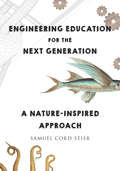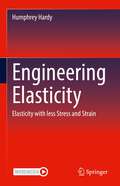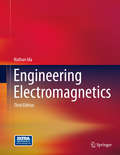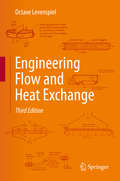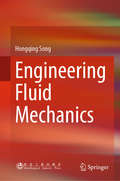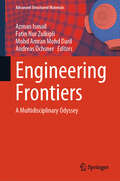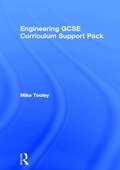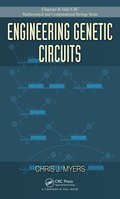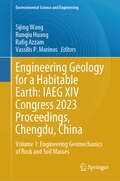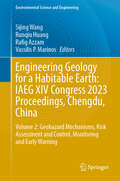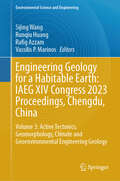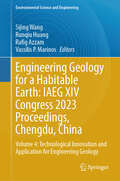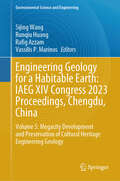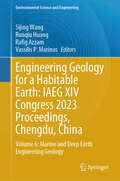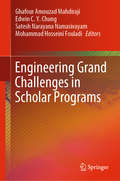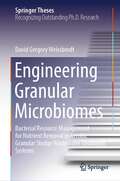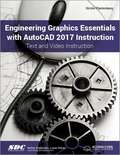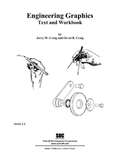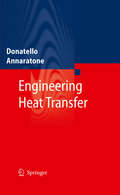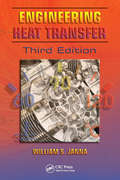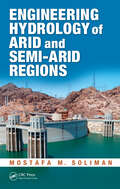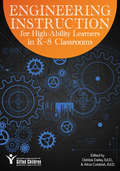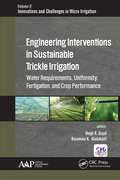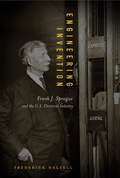- Table View
- List View
Engineering Education for the Next Generation: A Nature-inspired Approach
by Samuel Cord StierGuide your students through the fascinating world of engineering, and how to draw inspiration from Nature’s genius to create, make, and innovate a better human-built world. Studded with more than 150 illustrations of natural phenomena and engineering concepts, this fascinating and practical book clearly demonstrates how engineering design is broadly relevant for all students, not just those who may become scientists or engineers. Mr. Stier describes clever, engaging activities for students at every grade level to grasp engineering concepts by exploring the everyday design genius of the natural world around us. Students will love learning about structural engineering while standing on eggs; investigating concepts in sustainable design by manufacturing cement out of car exhaust; and coming to understand how ant behavior has revolutionized the way computer programs, robots, movies, and video games are designed today. You will come away with an understanding of engineering and Nature unlike any you’ve had before, while taking your ability to engage students to a whole new level. Engineering Education for the Next Generation is a wonderful introduction to the topic for any teacher who wants to understand more about engineering design in particular, its relation to the larger subjects of STEM/STEAM, and how to engage students from all backgrounds in a way that meaningfully transforms their outlook on the world and their own creativity in a lifelong way. · Fun to read, comprehensive exploration of cutting-edge approaches to K-12 engineering education · Detailed descriptions and explanations to help teachers create activities and lessons · An emphasis on engaging students with broad and diverse interests and backgrounds · Insights from a leading, award-winning K-12 engineering curriculum that has reached thousands of teachers and students in the U.S. and beyond · Additional support website (www.LearningWithNature.org) providing more background, videos, curricula, slide decks, and other supplemental materials
Engineering Elasticity: Elasticity with less Stress and Strain
by Humphrey HardyThis textbook aimed at upper-level undergraduate and graduate engineering students who need to describe the large deformation of elastic materials like soft plastics, rubber, and biological materials. The classical approaches to finite deformations of elastic materials describe a dozen or more measures of stress and strain. These classical approaches require an in-depth knowledge of tensor analysis and provide little instruction as to how to relate the derived equations to the materials to be described. This text, by contrast, introduces only one strain measure and one stress measure. No tensor analysis is required. The theory is applied by showing how to measure material properties and to perform computer simulations for both isotropic and anisotropic materials. The theory can be covered in one chapter for students familiar with Euler-Lagrange techniques, but is also introduced more slowly in several chapters for students not familiar with these techniques. The connection to linear elasticity is provided along with a comparison of this approach to classical elasticity.
Engineering Electromagnetics
by Nathan IdaThis book provides students with a thorough theoretical understanding of electromagnetic field equations and it also treats a large number of applications. The text is a comprehensive two-semester textbook. The work treats most topics in two steps - a short, introductory chapter followed by a second chapter with in-depth extensive treatment; between 10 to 30 applications per topic; examples and exercises throughout the book; experiments, problems and summaries. The new edition includes: modifications to about 30-40% of the end of chapter problems; a new introduction to electromagnetics based on behavior of charges; a new section on units; MATLAB tools for solution of problems and demonstration of subjects; most chapters include a summary. The book is an undergraduate textbook at the Junior level, intended for required classes in electromagnetics. It is written in simple terms with all details of derivations included and all steps in solutions listed. It requires little beyond basic calculus and can be used for self-study. The wealth of examples and alternative explanations makes it very approachable by students. · More than 400 examples and exercises, exercising every topic in the book · · Includes 600 end-of-chapter problems, many of them applications or simplified applications · · Discusses the finite element, finite difference and method of moments in a dedicated chapter
Engineering Flow and Heat Exchange
by Octave LevenspielThe third edition of Engineering Flow and Heat Exchange is the most practical textbook available on the design of heat transfer and equipment. This book is an excellent introduction to real-world applications for advanced undergraduates and an indispensable reference for professionals. The book includes comprehensive chapters on the different types and classifications of fluids, how to analyze fluids, and where a particular fluid fits into a broader picture. This book includes various a wide variety of problems and solutions - some whimsical and others directly from industrial applications. Numerous practical examples of heat transfer Different from other introductory books on fluids Clearly written, simple to understand, written for students to absorb material quickly Discusses non-Newtonian as well as Newtonian fluids Covers the entire field concisely Solutions manual with worked examples and solutions provided
Engineering Fluid Mechanics
by Hongqing SongThis book systematically introduces engineering fluid mechanics in a simple and understandable way, focusing on the basic concepts, principles and methods. Engineering fluid mechanics is necessary for professionals and students in fields such as civil, environmental, mechanical, and petroleum engineering. Unlike most of the current textbooks and monographs, which are too complicated and include huge numbers of math formulas and equations, this book introduces essential concepts and flow rules in a clear and elementary way that can be used in further research. In addition, it provides numerous useful tables and diagrams that can be quickly and directly checked for industry applications. Furthermore, it highlights the connection between free flow and porous flow, which can aid advanced interdisciplinary research such as nanotech and environmental science. Last but not least, each chapter presents a variety of problems to offer readers a better understanding about the principles and applications of fluid mechanics.
Engineering Frontiers: A Multidisciplinary Odyssey (Advanced Structured Materials #208)
by Andreas Öchsner Azman Ismail Mohd Amran Mohd Daril Fatin Nur ZulkipliThis book describes a diverse collection of engineering research and innovations across 35 chapters. Each chapter unveils a facet of modern engineering excellence. This book not only presents cutting-edge solutions but also addresses environmental sustainability. This book is an illuminating expedition into the heart of innovation, showcasing the ingenuity and collaborative spirit that define the future of engineering.
Engineering GCSE Curriculum Support Pack
by Mike TooleyUsed alongside the textbook Engineering GCSE, this pack offers a complete course for the new GCSE syllabuses from Edexcel and OCR, providing all the resources needed by a busy teacher or lecturer as well as a student-centred learning programme that will enable students to gain the skills, knowledge and understanding they require.The photocopiable materials in this pack include:* Background to running a GCSE Engineering course* Worksheets to support and develop work in the textbook* Assignments, practicals and design briefs* Reference material and revision sheets for use as handoutsThis pack builds on the success of Mike Tooley's GNVQ materials, which have helped thousands of students to gain their first engineering qualification.Mike Tooley is Vice Principal at Brooklands College, Surrey, and author of many engineering and electronics books.
Engineering Genetic Circuits (Chapman & Hall/CRC Computational Biology Series)
by Chris J. MyersThis text presents the modeling, analysis, and design methods for systems biology. It discusses how to examine experimental data to learn about mathematical models, develop efficient abstraction and simulation methods to analyze these models, and use analytical methods to design new circuits. The author reviews basic molecular biology and biochemistry principles, covers several methods for modeling and analyzing genetic circuits, and uses phage lambda as an example throughout to help illustrate the methods. He also explores the emerging area of synthetic biology. iBioSim software, lecture slides, and a password-protected solutions manual are available on the author's website.
Engineering Geology for a Habitable Earth: Volume 1: Engineering Geomechanics of Rock and Soil Masses (Environmental Science and Engineering)
by Rafig Azzam Runqiu Huang Vassilis P. Marinos Sijing WangThis book collects the selected papers of the XIV Congress of the International Association for Engineering Geology and the Environment held in Chengdu, Sichuan, China from September 21st - 27th, 2023, with the theme of Engineering Geology for a Habitable Earth. The meeting proceedings analyses the dynamic role of engineering geology in our changing world. The congress is expected to enhance the inter-disciplinary research development of international engineering geology and the environment, and contribute to the advancement of major projects, ecological progress, and habitable earth with in-depth discussion in the area of engineering geology and global climate change, geological hazard assessment and prevention, geotechnical properties of rock and soil mass, engineering geology and the environmental issues concerning marine, transportation, urban and ecological environment protection, engineering geology and resilience engineering construction, intelligent engineering geology, and new theories, methods, and techniques in engineering geology.
Engineering Geology for a Habitable Earth: Volume 2: Geohazard Mechanisms, Risk Assessment and Control, Monitoring and Early Warning (Environmental Science and Engineering)
by Rafig Azzam Runqiu Huang Vassilis P. Marinos Sijing WangThis book collects the selected papers of the XIV Congress of the International Association for Engineering Geology and the Environment held in Chengdu, Sichuan, China from September 21st - 27th, 2023, with the theme of Engineering Geology for a Habitable Earth. The meeting proceedings analyses the dynamic role of engineering geology in our changing world. The congress is expected to enhance the inter-disciplinary research development of international engineering geology and the environment, and contribute to the advancement of major projects, ecological progress, and habitable earth with in-depth discussion in the area of engineering geology and global climate change, geological hazard assessment and prevention, geotechnical properties of rock and soil mass, engineering geology and the environmental issues concerning marine, transportation, urban and ecological environment protection, engineering geology and resilience engineering construction, intelligent engineering geology, and new theories, methods, and techniques in engineering geology.
Engineering Geology for a Habitable Earth: Volume 3: Active Tectonics, Geomorphology, Climate and Geoenvironmental Engineering Geology (Environmental Science and Engineering)
by Rafig Azzam Runqiu Huang Vassilis P. Marinos Sijing WangThis book collects the selected papers of the XIV Congress of the International Association for Engineering Geology and the Environment held in Chengdu, Sichuan, China from September 21st - 27th, 2023, with the theme of Engineering Geology for a Habitable Earth. The meeting proceedings analyses the dynamic role of engineering geology in our changing world. The congress is expected to enhance the inter-disciplinary research development of international engineering geology and the environment, and contribute to the advancement of major projects, ecological progress, and habitable earth with in-depth discussion in the area of engineering geology and global climate change, geological hazard assessment and prevention, geotechnical properties of rock and soil mass, engineering geology and the environmental issues concerning marine, transportation, urban and ecological environment protection, engineering geology and resilience engineering construction, intelligent engineering geology, and new theories, methods, and techniques in engineering geology.
Engineering Geology for a Habitable Earth: Volume 4: Technological Innovation and Application for Engineering Geology (Environmental Science and Engineering)
by Rafig Azzam Runqiu Huang Vassilis P. Marinos Sijing WangThis book collects the selected papers of the XIV Congress of the International Association for Engineering Geology and the Environment held in Chengdu, Sichuan, China from September 21st - 27th, 2023, with the theme of Engineering Geology for a Habitable Earth. The meeting proceedings analyses the dynamic role of engineering geology in our changing world. The congress is expected to enhance the inter-disciplinary research development of international engineering geology and the environment, and contribute to the advancement of major projects, ecological progress, and habitable earth with in-depth discussion in the area of engineering geology and global climate change, geological hazard assessment and prevention, geotechnical properties of rock and soil mass, engineering geology and the environmental issues concerning marine, transportation, urban and ecological environment protection, engineering geology and resilience engineering construction, intelligent engineering geology, and new theories, methods, and techniques in engineering geology.
Engineering Geology for a Habitable Earth: Volume 5: Megacity Development and Preservation of Cultural Heritage Engineering Geology (Environmental Science and Engineering)
by Rafig Azzam Runqiu Huang Vassilis P. Marinos Sijing WangThis book collects the selected papers of the XIV Congress of the International Association for Engineering Geology and the Environment held in Chengdu, Sichuan, China from September 21st - 27th, 2023, with the theme of Engineering Geology for a Habitable Earth. The meeting proceedings analyses the dynamic role of engineering geology in our changing world. The congress is expected to enhance the inter-disciplinary research development of international engineering geology and the environment, and contribute to the advancement of major projects, ecological progress, and habitable earth with in-depth discussion in the area of engineering geology and global climate change, geological hazard assessment and prevention, geotechnical properties of rock and soil mass, engineering geology and the environmental issues concerning marine, transportation, urban and ecological environment protection, engineering geology and resilience engineering construction, intelligent engineering geology, and new theories, methods, and techniques in engineering geology.
Engineering Geology for a Habitable Earth: Volume 6: Marine and Deep Earth Engineering Geology (Environmental Science and Engineering)
by Rafig Azzam Runqiu Huang Vassilis P. Marinos Sijing WangThis book collects the selected papers of the XIV Congress of the International Association for Engineering Geology and the Environment held in Chengdu, Sichuan, China from September 21st - 27th, 2023, with the theme of Engineering Geology for a Habitable Earth. The meeting proceedings analyses the dynamic role of engineering geology in our changing world. The congress is expected to enhance the inter-disciplinary research development of international engineering geology and the environment, and contribute to the advancement of major projects, ecological progress, and habitable earth with in-depth discussion in the area of engineering geology and global climate change, geological hazard assessment and prevention, geotechnical properties of rock and soil mass, engineering geology and the environmental issues concerning marine, transportation, urban and ecological environment protection, engineering geology and resilience engineering construction, intelligent engineering geology, and new theories, methods, and techniques in engineering geology.
Engineering Grand Challenges in Scholar Programs
by Ghafour Amouzad Mahdiraji Edwin C.Y. Chung Satesh Narayana Namasivayam Mohammad Hosseini FouladiThis book explains how Taylor’s University implemented a curriculum in their engineering program that prepares students to address challenges facing the world. Aim is to enable Engineers put their knowledge into application to meet the 14 challenges of the century as outlined by the National Academy of Engineering (NAE) of the United States. The research groups are organized around the 14 grand challenges for engineering The structure of their syllabi is organized in a way that they address the 5 core competencies: Research Experience, Entrepreneurship, Service Learning, Interdisciplinary Curriculum, Global Dimension. It uses the CDIO educational framework, a project-based learning approach that provides students with the big picture of engineering. Through this method, students are able to: Master a deeper working knowledge of the fundamentals of engineering Lead in the creation and operation of new products and systems Understand the importance and strategic value of research work As the only programe of its kind outside North America, it offers the brightest minds the opportunity to face real-world issues and places them on the cutting edge of the engineering world.
Engineering Granular Microbiomes: Bacterial Resource Management for Nutrient Removal in Aerobic Granular Sludge Wastewater Treatment Systems (Springer Theses)
by David Gregory WeissbrodtThis book reports on the ecological engineering of granular sludge processes for a high-rate removal of carbon, nitrogen, and phosphorus nutrients in compact wastewater treatment plants. It provides novel insights into microorganisms and metabolisms in wastewater microbiomes and the use of microbial ecology principles to manage wastewater treatment processes. It covers a very comprehensive and inter-disciplinary research of systems microbiology and environmental biotechnology. From the initial economic assessment of the aerobic granular sludge technology, concepts of microbiome science and engineering are developed to uncover and manage the microbial ecosystem of granular sludge. Mixed-culture biotechnological processes, multifactorial experimental designs, laser scanning microscopy, molecular microbial ecology and bioinformatics methods, numerical ecology workflows, and mathematical modelling are engaged to disentangle granulation phenomena, microbial selection, and nutrient conversions across scales. The findings are assembled in a guideline for microbial resource management in granular sludge processes to support knowledge utilization in engineering practice. Outputs are integrated in the state of the art of biological wastewater treatment. This book addresses both scientists and engineers who are eager to get insights into and engineer microbiomes for environmental biotechnologies. It makes a valuable contribution to methods for strengthening the role of wastewater treatment plants for recovering safe water and resources, in the context of circular economy and for sustaining health and the environment in an ecologically balanced society.
Engineering Graphics Essentials With AutoCAD 2017 Instruction
by Kirstie PlantenbergEngineering Graphics Essentials with AutoCAD 2009 Instruction covers the main topics of engineering graphics, including tolerancing and fasteners, giving the user a basic understanding of how to create and read engineering drawings as well as teaching them the fundamentals of AutoCAD 2009.
Engineering Graphics: Text and Workbook
by Jerry W. Craig Orval B. Craig<p>This book focuses on strengthening 3D visualization skills through sketching exercises. It does not make reference to any particular computer-aided design software package. Points emphasized: <p> <br>1. Shape representation and problem solving using freehand sketching. Assignments can be completed outside class. <br>2. Surface Analysis -- A powerful approach to teaching visualization. <br>3. Establishes a process for solving problems. Students can solve features of objects before they can see; the shapes. <br>4. Challenging problems. Worksheet layouts allow faster progress. <br>5. Students learn how to think about shapes in three dimensions. <br>6. Students can prove every line on a drawing. There is no question whether the answer is correct or not.</br> </p>
Engineering Heat Transfer
by Donatello AnnaratoneThis book is a generalist textbook; it is designed for anybody interested in heat transmission, including scholars, designers and students. Two criteria constitute the foundation of Annaratone's books, including the present one. The first one consists of indispensable scientific rigor without theoretical exasperation. The inclusion in the book of some theoretical studies, even if admirable for their scientific rigor, would have strengthened the scientific foundation of this publication, yet without providing the reader with further applicable know-how. The second criterion is to deliver practical solution to operational problems. This criterion is fulfilled through equations based on scientific rigor, as well as a series of approximated equations, leading to convenient and practically acceptable solutions, and through diagrams and tables. When a practical case is close to a well defined theoretical solution, corrective factors are shown to offer simple and correct solutions to the problem.
Engineering Heat Transfer (Heat Transfer)
by William S. JannaMost heat transfer texts include the same material: conduction, convection, and radiation. How the material is presented, how well the author writes the explanatory and descriptive material, and the number and quality of practice problems is what makes the difference. Even more important, however, is how students receive the text. Engineering Heat Transfer, Third Edition provides a solid foundation in the principles of heat transfer, while strongly emphasizing practical applications and keeping mathematics to a minimum.
Engineering Heat Transfer (Heat Transfer)
by William S. JannaMost heat transfer texts include the same material: conduction, convection, and radiation. How the material is presented, how well the author writes the explanatory and descriptive material, and the number and quality of practice problems is what makes the difference. Even more important, however, is how students receive the text. Engineering Heat Transfer, Third Edition provides a solid foundation in the principles of heat transfer, while strongly emphasizing practical applications and keeping mathematics to a minimum. New in the Third Edition: Coverage of the emerging areas of microscale, nanoscale, and biomedical heat transfer Simplification of derivations of Navier Stokes in fluid mechanics Moved boundary flow layer problems to the flow past immersed bodies chapter Revised and additional problems, revised and new examples PDF files of the Solutions Manual available on a chapter-by-chapter basis The text covers practical applications in a way that de-emphasizes mathematical techniques, but preserves physical interpretation of heat transfer fundamentals and modeling of heat transfer phenomena. For example, in the analysis of fins, actual finned cylinders were cut apart, fin dimensions were measures, and presented for analysis in example problems and in practice problems. The chapter introducing convection heat transfer describes and presents the traditional coffee pot problem practice problems. The chapter on convection heat transfer in a closed conduit gives equations to model the flow inside an internally finned duct. The end-of-chapter problems proceed from short and simple confidence builders to difficult and lengthy problems that exercise hard core problems solving ability. Now in its third edition, this text continues to fulfill the author’s original goal: to write a readable, user-friendly text that provides practical examples without overwhelming the student. Using drawings, sketches, and graphs, this textbook does just that.PDF files of the Solutions Manual are available upon qualifying course adoptions.
Engineering Hydrology of Arid and Semi-Arid Regions
by Mostafa M. SolimanThe natural scarcity of water in arid and semiarid regions, aggravated by man-made factors, makes it difficult to achieve a reliable water resources supply. Communities in these areas pay the price for thousands of years of water manipulation. Presenting important insight into the complexities of arid region hydrology, Engineering Hydrology of Arid
Engineering Instruction for High-Ability Learners in K-8 Classrooms
by Alicia Cotabish Debbie DaileyEngineering Instruction for High-Ability Learners in K-8 Classrooms is an application-based practitioners' guide to applied engineering that is grounded in engineering practices found in the new Next Generation Science Standards (NGSS) and the Standards for Engineering Education. The book will provide educators with information and examples on integrating engineering into existing and newly designed curriculum. The book will specify necessary components of engineering curriculum and instruction, recommend appropriate activities to encourage problem solving, creativity, and innovation, and provide examples of innovative technology in engineering curriculum and instruction. Additionally, authors will discuss professional development practices to best prepare teachers for engineering instruction and provide recommendations to identify engineering talent among K-8 students. Finally, the book will include a wealth of resources, including sample lesson and assessment plans, to assist educators in integrating engineering into their curriculum and instruction.
Engineering Interventions in Sustainable Trickle Irrigation: Irrigation Requirements and Uniformity, Fertigation, and Crop Performance (Innovations in Agricultural & Biological Engineering)
by Megh R. Goyal Basamma K. AladakattiImproving agricultural water use efficiency (WUE) is vitally important in many parts of the world due to the decreasing availability of water resources and the increasing competition for water between different users. Micro irrigation is an effective tool for conserving water resources. Studies have revealed a significant water savings, ranging from 40% to 70% under drip irrigation compared with surface irrigation. This new volume, Engineering Interventions in Sustainable Trickle Irrigation: Irrigation Requirements and Uniformity, Fertigation, and Crop Performance, presents valuable research that evaluates crop water and fertigation requirements, examines optimum irrigation and fertigation scheduling, and analyzes the performance of agricultural crops under micro irrigation. <P><P> With an interdisciplinary perspective, this volume addresses the urgent need to explore and investigates the current shortcomings and challenges of water resources engineering, especially in micro irrigation engineering. The volume discusses crop water requirements, fertigation technology, and performance of agricultural crops under best management practices. The chapter authors present research studies on drip irrigated tomato, chilies, cucumber, eggplant, cabbage, garlic, sugarcane maize, cashew nut, sapota, banana, mango, and blueberries. <P><P> Removing the research gap, this volume provides new information that will be valuable to those involved in micro irrigation engineering.
Engineering Invention: Frank J. Sprague and the U.S. Electrical Industry
by Frederick DalzellThe technological breakthroughs and entrepreneurial adventures of Frank J. Sprague during the transformative years of the early electrical industry. Over the course of a little less than twenty years, inventor Frank J. Sprague (1857-1934) achieved an astonishing series of technological breakthroughs—from pioneering work in self-governing motors to developing the first full-scale operational electric railway system—all while commercializing his inventions and promoting them (and himself as their inventor) to financial backers and the public. In Engineering Invention, Frederick Dalzell tells Sprague's story, setting it against the backdrop of one of the most dynamic periods in the history of technology. In a burst of innovation during these years, Sprague and his contemporaries—Thomas Edison, Nicolas Tesla, Elmer Sperry, George Westinghouse, and others—transformed the technologies of electricity and reshaped modern life. After working briefly for Edison, Sprague started the Sprague Electric Railway and Motor Company; designed and built an electric railroad system for Richmond, Virginia; sold his company to Edison and went into the field of electric elevators; almost accidentally discovered a multiple-control system that could equip electric train systems for mass transit; started a third company to commercialize this; then sold this company to Edison and retired (temporarily). Throughout his career, Dalzell tells us, Sprague framed technology as invention, cast himself as hero, and staged his technologies as dramas. He toiled against the odds, scraped together resources to found companies, bet those companies on technical feats—and pulled it off, multiple times. The idea of the “heroic inventor” is not, of course, the only way to frame the history of technology. Nevertheless, as Dalzell shows, Sprague, Edison, and others crafted the role consciously and actively, using it to generate vital impetus behind the process of innovation.
